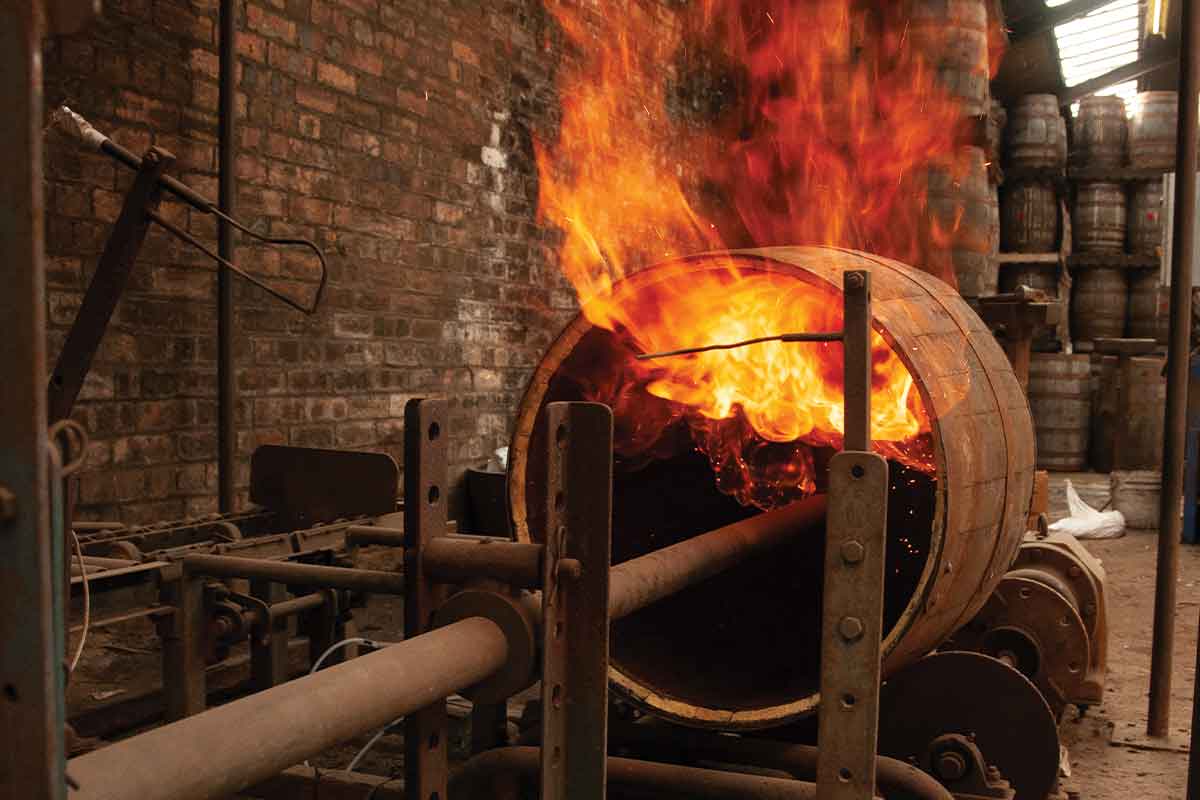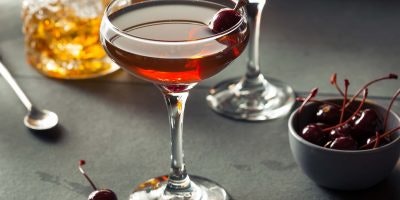Consider all of the variables that impact a new barrel used for whiskey maturation. There’s the type of oak used — including factors like where it’s sourced from, from what part of the tree, and from how old of a tree. Certainly the size of the barrel makes a difference. Additionally whether the staves were kilned or dry-seasoned and for how long is a factor. And of course, there’s the consideration of whether to use charred barrels or toasted barrels. Charred barrels have become synonymous with American whiskey. That’s because new, charred oak barrels are mandatory in the production of bourbon, rye and other American whiskeys.
Of course, this wasn’t always the case. Just as the use of barrels altogether developed by happenstance — barrels were used for shipping whiskey, and producers found that the liquid was improved upon delivery — so too is the act of charring them. Barrels were commonly used as long as they were steadfast. But one shipment’s whiskey might be another’s beer or molasses, or meat, for that matter. The inside of barrels were therefore burned to cleanse them of any remaining aromas and flavors.
This went onto become the secret sauce to American whiskey maturation, and further, whiskey maturation around the world. Even if used bourbon barrels are the foundation of a Scotch whisky’s maturation, those used barrels have still, of course, been charred.
Charring Barrels Doesn’t Just Look Cool; It’s Science
There’s a high level of scientific understanding about the whats, whys and hows of the process today. Take it from Don Livermore, PhD., Hiram Walker & Sons master blender. He uses the analogy of taking a wrecking ball to a brick wall, breaking apart wood fiber and its large compounds of cellulose, hemicellulose and lignin, into smaller, dissolvable molecules which unleash their flavors into the whiskey.
 Charring barrels
Charring barrels
“The cheapest and most effective way to break apart wood fiber is by fire,” Livermore says. He explains that cellulose and hemicellulose, once broken down into constituent components, contribute flavors such as caramel, toffee, nutty, and maple. Meanwhile lignin offers vanilla, smoky, leather, spice and creamy flavors.
As another example, consider esterification. “When oak tannins are thermally degraded, the byproducts react with the natural oxygen that enters the cask through the joint in the staves to produce acetic acid,” Livermore says. Acetic acid undergoes the Fisher Reaction, or esterification, and is converted into ethyl acetate within the barrel, among numerous reactions, conversions, and breakdowns taking place. Similarly, lactones are developed from the thermal degradation of lipids in the wood.
Other Variables
Different varieties of oak – and even oak sourced from different areas, bringing wood terroir into the mix – have signature levels of particular compounds. These compounds then go onto impact which flavors or how much of a particular flavor may develop. “It’s almost like DNA,” Livermore says. “Each has its own unique makeup of cellulose, hemicellulose, lignin and lipid, thus when thermally degraded it will produce its own unique flavors.”
Not all char is created equal. Cooperages and distilleries reference a scale of level one to level four for charred barrels. The level number extends upwards in the length of burning from 10 to 15 seconds, to just under a minute. The famed level four char is known as alligator char, for the thick, scaly-like texture appearing on the burnt staves. The vast majority of bourbon is matured in either level three or level four charred barrels.
The Impact of Toasting
If charring the inside of a barrel is burning it, then toasting is more like baking it; you’re looking to change or develop a flavor but more gently, rather than with intense, destructive physical force.
“If you pre-toast the wood, you can better control your vanillin, your vanilla, and your color,” explains Woodford Reserve Master Distiller Chris Morris.
Charring and toasting need not be mutually exclusive, either. In fact, it’s common for producers to follow a regimen of toasting and charring in tandem. They then can dial up one or the other in order to pursue specific qualities and flavors.
That’s the case at the Brown-Forman cooperage. This company produces barrels for Jack Daniel’s as well as stablemate brands such as Woodford Reserve, to the tune of more than 2,500 per day. They both toast and char. This is why Morris refers to the process as “pre-toasting” – accomplishing the toasting via a proprietary method of radiant heat.
Charring too much leads to an inevitable conclusion. But pre-toasting is a way to boost reactions without irreparably damaging or destroying the wood in the same way. “You can only char a barrel so long until it burns up,” Morris says. “By pre-toasting, you’re not burning the barrel, you’re just applying heat to it. The wood is not at risk, you can toast long, short, whatever you want. Deep set your vanillas, deep set your color.”
Time and Temperature
Determining the proper length of time to toast, as well as the proper length of time to char, are two of the three most crucial variables Morris cites in the creation of barrels. The third is the length of the dry seasoning process.
According to Macallan Master of Wood Stuart MacPherson, there’s more to the toasting process than duration, too. “A lot of the flavor variances could be down to your actual toasting temperatures as well,” he says. MacPherson may not be hands-on with the charring of new bourbon barrels. But he’s well-acquainted with the toasting process from the brand’s intensive construction of sherry casks.
Back to bourbon, while all bourbon must be matured in new, charred oak, inventive finishing processes have allowed for the use of barrels or staves which have been toasted but not charred. Look no further than Maker’s Mark 46, and the Wood Finishing Series which has followed in its wake.
Fire and heat give life, and for whiskey, the water of life, they give flavor.
Ready to try some whiskeys influenced by toasted and charred barrels?
With Distiller, you’ll always know what’s in the bottle before you spend a cent. Rate, Review, and Discover spirits. Head on over to Distiller, or download the app for iOS and Android today!
Want to enjoy Distiller ad-free? Join Distiller Pro today to support the Distiller platform and keep ads off of your screen.


